新标准(一起)小学英语四年级上M10Unit1英语教案
- 格式:doc
- 大小:20.55 KB
- 文档页数:3

Module10 Unit1 参考教案一、教学内容外语教学与研究出版社(一起点)四年级上册第十模块Unit1 Go to bed early.二、教学过程建议(一)热身导入1.请学生说SB Module 9 Unit2活动1的韵句,并演唱SB Module9 Unit2活动4的歌曲。
2.播放SB Unit1 活动1的动画或录音,请学生看动画或边听录音边看挂图,理解语境:大公鸡说自己每天起得很早,猫头鹰则说自己起得很晚,在白天睡觉。
3.再次播放录音,请学生看图跟读。
跟读过程中,学习“early,every, during”的语义,并对“early,every”进行运用训练。
4.请学生全班跟读、小组跟读、个人跟读,然后请部分学生向全班展示。
(二)任务呈现教师告诉学生今天,我们要在小组内调查大家的日常生活习惯,看看大家的饮食和作息习惯是否健康。
同学们还记得上一模块里Darning撞了头吧?这回,Sam又出了状况。
我们来看一下Sam得了什么病,是什么导致他生病的。
”(三)课文学习1.播放SB Unit1活动2的动画或录音,请学生看动画或边听录音边看挂图,教师帮助学生理解课文语境。
2.再次播放录音,请学生完整听一遍对话,进一步理解语句。
播放第三遍录音,请学生逐句跟读。
对于学生跟读有困难的语句,教师可按照意群、节奏重点带读,请学生注意模仿语音语调。
3.在跟读过程中,通过展示图片、做动作等方式,学习“computer game,take, medicine! a lot of, exercise”的语义,并通过造句练习对“take,exercise”进行运用训练。
4.完成AB Unit1练习1。
这是课文阅读理解练习。
先请学生看图,阅读问题和选项,熟悉题目内容。
然后完整播放一遍录音,请学生整体感知。
再次播放录音,逐题停顿,请学生作答。
教师可以请部分学生说出答案。
播放第三遍录音,全班核对答案。
5.完成AB Unit1练习2。
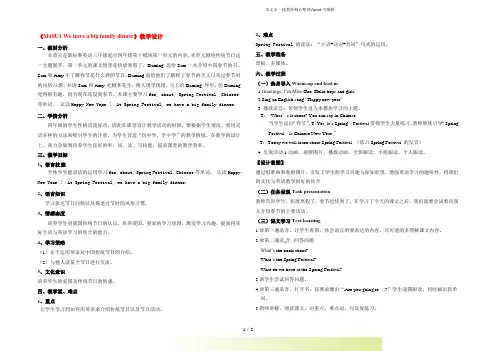
《M10U1 We have a big family dinner》教学设计一、教材分析本单元是新标准英语三年级起点四年级第十模块第一单元的内容,本单元围绕传统节日这一主题展开。
第一单元的课文情景是快放寒假了,Daming 送给Sam一本介绍中国春节的书。
Sam和Amy不了解春节是什么样的节日,Daming就给他们了解释了春节的含义以及过春节时的风俗习惯,并请Sam和Amy 吃糖和花生,两人现学现用,马上给Daming 拜年,但Daming 觉得很有趣,因为现在还没到春节。
本课主要学习for, about, Spring Festival ,Chinese 等单词。
认读Happy New Year ! At Spring Festival, we have a big family dinner.二、学情分析四年级的学生性格活泼好动,因此在课堂设计教学活动的时候,要根据学生情况,要用灵活多样的方法来吸引学生的注意,为学生营造“玩中学,学中学”的教学情境。
在教学的设计上,我力争做到培养学生良好的听、说、读、写技能,提高课堂的教学效率。
三、教学目标1、语言技能全体学生能灵活的运用学习for, about, Spring Festival ,Chinese等单词。
认读Happy New Year ! At Spring Festival, we have a big family dinner.2、语言知识学习表达节日问候以及描述过节时的风俗习惯。
3、情感态度培养学生对我国传统节日的认识,培养爱国、爱家的学习氛围,激发学习兴趣,提高将实际生活与英语学习的结合的能力。
4、学习策略(1)乐于运用英语对中国传统节日的介绍。
(2)与他人就某个节日进行交流。
5、文化意识培养学生的爱国及传统节日的情感。
四、教学重、难点1、重点让学生学习到如何用英语来介绍传统节日以及节日活动。
2、难点Spring Festival 的读法;“主语+动词+名词”句式的运用,五、教学准备黑板、多媒体。
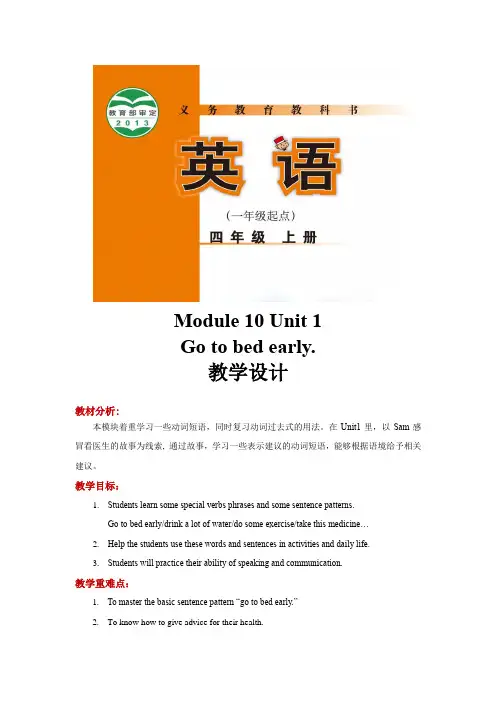
Module 10 Unit 1Go to bed early.教学设计教材分析:本模块着重学习一些动词短语,同时复习动词过去式的用法。
在Unit1里,以Sam 感冒看医生的故事为线索, 通过故事,学习一些表示建议的动词短语,能够根据语境给予相关建议。
教学目标:1. Students learn some special verbs phrases and some sentence patterns.Go to bed early/drink a lot of water/do some exercise/take this medicine …2. Help the students use these words and sentences in activities and daily life.3. Students will practice their ability of speaking and communication.教学重难点:1. To master the basic sentence pattern “go to bed early.”2.To know how to give advice for their health.3.To master some verbs like play/take/drink/do…教学准备:Multimedia, cards, ppt, and CD-ROM.教学过程:1.Warm-up1). Free talk: “When do you get up in the morning?” & “When do you go to bed at night?”Show them some animals on the screen, and ask them: “When do you get up in the morning?”and “When do you go to bed at night?”T: Boys and girls, please look at the screen. This is my timetable. Please read it carefully, and tell me, when do I get up in the morning?S1: You get up at 6:00.T: Great! I get up early in the morning. When do I go to bed at night?S2: You go to bed at 11:30.T: Oh, yes. I go to bed at 11:30 at night. It’s too late. Do you think so?Ss: Yes, you go to bed too late.T: Is my lifestyle healthy?Ss: No, you should go to bed early.(It’s ok if they speak in Chinese.)T: Ok! Your advice is pretty good for me. When do you get up in the morning?S3: …T: When do you go to bed at night?S4: …T: That’s good! You get up early in the morning and go to bed early at night.2). Activity 1. Listen, point and say.T: Boys and girls, look here. What’s this animal?Ss: It’s a chicken. (It’s ok if they speak Chinese.)T: Yes, it’s a cock. When does it get up? Early or late?Ss: Early.T: Perfect! How about this animal?Ss: Wow! An owl.T: Right! It’s an owl. When does it get up? In the morning or at night?T: Good! It gets up late. Now let’s listen to the tape.Play the CD-ROM.【设计意图】The free talk will draw students’ attention and their interests. They will have a review on some verbal phrases and the main topic. This process will make them ready for the class, make them familiar with the new sentence pattern and lead in the new topic of this lesson. 2.Presentation1). Activity2. Listen, point and find.T: Boys and girls, look at this picture. Who is he?Ss: He is Sam.T: Does he look happy?Ss: No, he looks unhappy.T: What’s the matter with him?Ss: …(students guess, and it’s ok if they speak Chinese.)T: Well, let’s listen to the tape and check the answer.Play the CD-ROM.T: Boys and girls, where is Sam?Ss: he is in the hospital.T: What’s wrong with him?Ss: He’s got a cold.T: What did he do yesterday?Now, let’s listen to the tape again. And answer my question.Question 1: what did he do yesterday?Question 2: what’s the doctor’s suggestion?2). Listen again for detailed information.Play the CD-ROM again.Discuss and check the answer.Learn early & lateLearn duringLearn have got a coldLearn take this medicine & drink a lot of water & do some exercise3). Listen again and read.Play the CD-ROM again, and read after it.T: Boys and girls, now we will listen to the tape again. This time, please try to imitate the pronunciation and intonation.【设计意图】This procedure is to learn the new text. The Task-based method is used to lead students to read the story carefully and get information from the text. Imitation and repeat will improve students’ pronunciation.3.Practice1). Role-play.Students will read the story by group, or by role.2). Pair work: Activity3 on page58.Make a new story about this topic. Two students work in one group. And try to play it out.3). Practice Activity4 on page58.【设计意图】The new knowledge they have learned will be consolidated, and they will practice their skill of communication and expression.4.SummaryStudents sum up the knowledge they have learned.【设计意图】The summary is another kind of consolidation.5.Homework1). Listen to the story 3 times and try to retell it to your parents.2). Copy the key sentence and key words 3 times.【设计意图】Let students do some exercises after class to consolidate the knowledge they have learned.教学反思:。
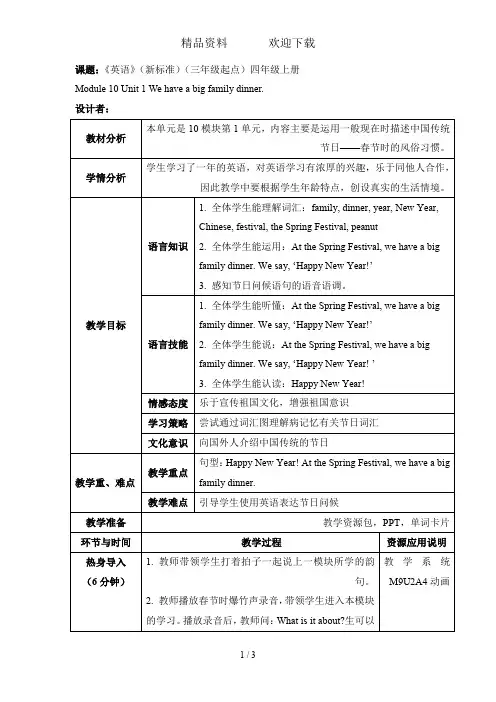
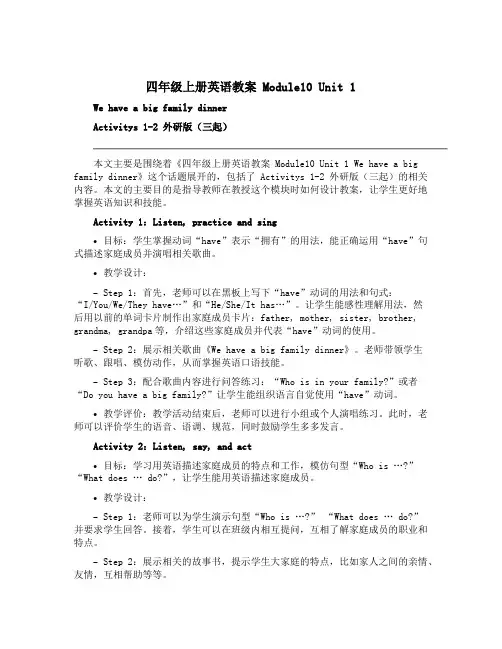
四年级上册英语教案 Module10 Unit 1We have a big family dinnerActivitys 1-2 外研版(三起)本文主要是围绕着《四年级上册英语教案 Module10 Unit 1 We have a big family dinner》这个话题展开的,包括了 Activitys 1-2 外研版(三起)的相关内容。
本文的主要目的是指导教师在教授这个模块时如何设计教案,让学生更好地掌握英语知识和技能。
Activity 1:Listen, practice and sing•目标:学生掌握动词“have”表示“拥有”的用法,能正确运用“have”句式描述家庭成员并演唱相关歌曲。
•教学设计:–Step 1:首先,老师可以在黑板上写下“have”动词的用法和句式:“I/You/We/They have…”和“He/She/It has…”。
让学生能感性理解用法,然后用以前的单词卡片制作出家庭成员卡片:father, mother, sister, brother, grandma, grandpa等,介绍这些家庭成员并代表“have”动词的使用。
–Step 2:展示相关歌曲《We have a big family dinner》。
老师带领学生听歌、跟唱、模仿动作,从而掌握英语口语技能。
–Step 3:配合歌曲内容进行问答练习:“Who is in your family?”或者“Do you have a big family?”让学生能组织语言自觉使用“have”动词。
•教学评价:教学活动结束后,老师可以进行小组或个人演唱练习。
此时,老师可以评价学生的语音、语调、规范,同时鼓励学生多多发言。
Activity 2:Listen, say, and act•目标:学习用英语描述家庭成员的特点和工作,模仿句型“Who is …?” “What does … do?”,让学生能用英语描述家庭成员。
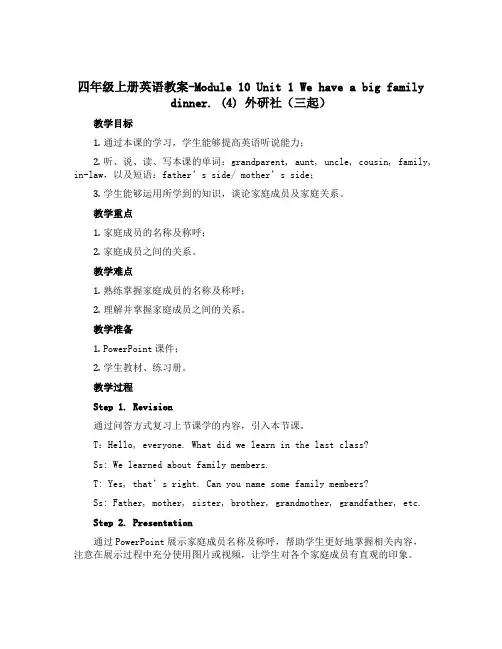
四年级上册英语教案-Module 10 Unit 1 We have a big familydinner. (4) 外研社(三起)教学目标1.通过本课的学习,学生能够提高英语听说能力;2.听、说、读、写本课的单词:grandparent, aunt, uncle, cousin, family, in-law,以及短语:father’s side/ mother’s side;3.学生能够运用所学到的知识,谈论家庭成员及家庭关系。
教学重点1.家庭成员的名称及称呼;2.家庭成员之间的关系。
教学难点1.熟练掌握家庭成员的名称及称呼;2.理解并掌握家庭成员之间的关系。
教学准备1.PowerPoint课件;2.学生教材、练习册。
教学过程Step 1. Revision通过问答方式复习上节课学的内容,引入本节课。
T:Hello, everyone. What did we learn in the last class?Ss: We learned about family members.T: Yes, that’s right. Can you name some family members?Ss: Father, mother, sister, brother, grandmother, grandfather, etc.Step 2. Presentation通过PowerPoint展示家庭成员名称及称呼,帮助学生更好地掌握相关内容,注意在展示过程中充分使用图片或视频,让学生对各个家庭成员有直观的印象。
T: Now let’s learn some new family members. Look at the picture, this is my father. He is the son of my grandparents. So what should I call my grandparents?Ss: Grandmother and grandfather.T: Very good. How about this lady? (Show a picture of an aunt)Ss: Aunt.T: And this man? (Show a picture of an uncle)Ss: Uncle.T: How about this boy and girl? (Show pictures of cousins)Ss: Cousins.T: Good job. And do you know what the wife of a man’s brother is called?Ss: Sister-in-law.T: Right. How about the husband of a woman’s sister?Ss: Brother-in-law.Step 3. Practice让学生进行练习,主要是分组练习及课堂问答,以巩固所学知识。
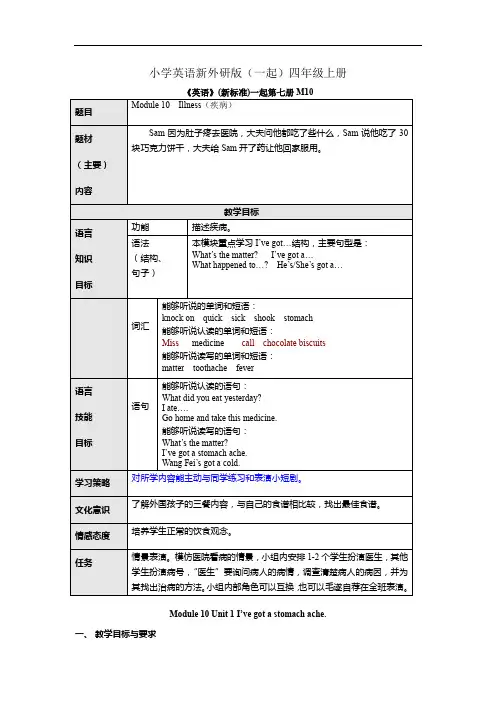
小学英语新外研版(一起)四年级上册Module 10 Unit 1 I’ve got a stomach ache. 一、教学目标与要求1.知识与能力目标知识目标:能够听说读写语句:What’s the matter? I’ve got a stomach ache.和单词matter能力目标:能够在医院与医生进行简单的交流。
2.情感态度目标培养学生正常的饮食观念。
二、教学重点及难点能够听说认读写下列句子:What’s the matter? I’ve got a stomach ache.能够仿说和运用下列句子:What’s the matter? I’ve got a….三、课前准备CD-ROOM ,word cards, medicine, activity book.四、教学过程Step 1 Warm up1. Let’s chant.Cold, cold, I’ve got a cold.Cough, cough, I’ve got a cough.Headache, headache, headache, I’ve got a headache.Stomach ache, stomach ache, I’ve got a stomach ache.Ss do action and chant.设计意图:通过节奏明快的唱游复习学过的病情,使学生在轻松愉快的氛围中进入到课堂学习中,再加上学生生动的肢体语言,使复习效果更好,同时也为下一环节作铺垫。
Step 2 Present1.利用chant所做的最后一个胃痛得动作。
T: What’s the matter?S1: I’ve got a stomach ache.T: Go home and take this medicine.引出主句型:What’s the matter?I’ve got a stomach ache.Read the first sentence.A.领读。
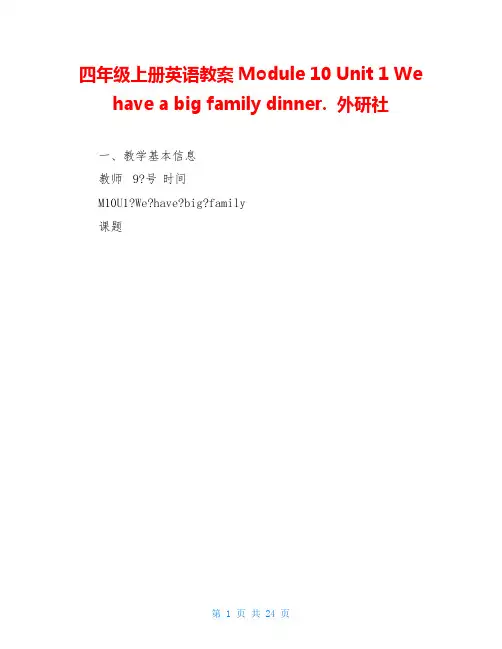
四年级上册英语教案Module 10 Unit 1 We have a big family dinner. 外研社一、教学基本信息教师9?号时间M10U1?We?have?big?family课题课型?newdinner二、教学背景分析^p本单元围绕?Spring?Festival?这一主题展开,快放寒假了,Daming?送给?Sam?一本介绍中国春节的书。
Sam?和?Amy?不了解春节是什么样的节日,Daming?就给他们解释了春节的含义以及过春节时的风俗习惯,并请?Sam?和?Amy?吃糖和花生,两人现学现用,马上给?Daming?拜年,但?Daming?觉得很有趣,因为现在还没到春节。
课文运用?we……句型描述节日的活动,学生易于接受。
三、教学目标1.?知识技能目标:(1)能听说读认单词:family,?dinner,?New?Year,?theSpring?Festival?,Chinese,?peanut?,I?see.(2)能听懂并会说句子:Happy?New?Year?!?用?At?Spring?Festival?,?we……描述春节活动。
2. 过程方法目标:(1)在简短的?chant?下,巩固课文中单词。
(2)通过听音填空,听音选择,听音判断等学习句型we……(3)通过整体听课文复述课文,摘苹果的方式巩固单词,思维导图的方式总结,加强课文重点句的学习。
3. 情感态度目标:(1)培养学生爱家的情感,激发学习兴趣,提高将实际生活与英语学习的结合的能力。
(2)培养学生对我国传统节日的热爱以及对我们祖国的热爱。
四、教学重难点第?1?页教学重点:能运用?At?Spring?Festival,?we…来描述春节场景。
教学难点:单词?spring,festival、family?的正确发音。
小学英语备课卡五、教学过程GreetingsGreetings Greetings.时间一、Warm- up 二、Lead- in教师活动学生活动?设计意图师生简单问好,拉近师T:two?groups生距离,创sweets?group造和谐的上peanuts?group?课氛围。
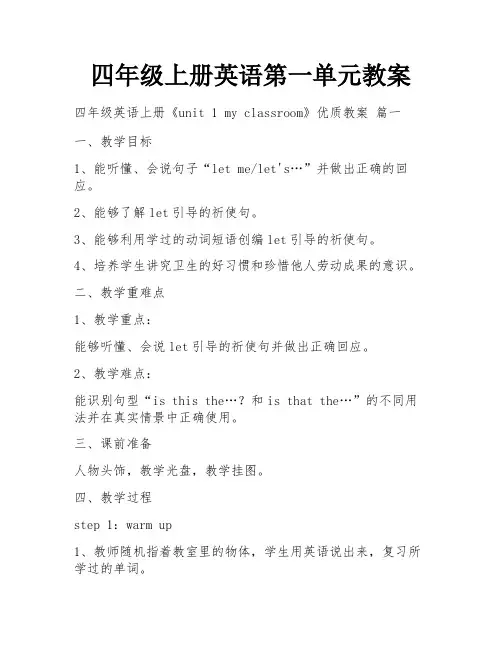
四年级上册英语第一单元教案四年级英语上册《unit 1 my classroom》优质教案篇一一、教学目标1、能听懂、会说句子“let me/let's…”并做出正确的回应。
2、能够了解let引导的祈使句。
3、能够利用学过的动词短语创编let引导的祈使句。
4、培养学生讲究卫生的好习惯和珍惜他人劳动成果的意识。
二、教学重难点1、教学重点:能够听懂、会说let引导的祈使句并做出正确回应。
2、教学难点:能识别句型“is this the…?和is that the…”的不同用法并在真实情景中正确使用。
三、课前准备人物头饰,教学光盘,教学挂图。
四、教学过程step 1:warm up1、教师随机指着教室里的物体,学生用英语说出来,复习所学过的单词。
2、教师播放let's do部分的录音,让学生跟着录音练习课本第5页let's do部分的句子。
学生说说自己知道的祈使句或动词短语,老师鼓励学生上台带领其他学生边说边做动作。
step 2:presentation1、教师做擦黑板的动作,让学生发出相应的指令:clean the blackboard.从而引出单词clean,并教读,加深理解单词clean的意思。
然后教师说出需要打扫的地方,请学生用英语说出带有clean的动词短语,如:clean the windows;clean the desks(由clean the desks引出the teacher's desk.);clean the classroom;clean the doors…。
2、教师边擦窗户边说:“let me clean the windows.”并向学生解释“let me…”的含义以及用法。
找几名学生说出更多“let me…”的句子,边说边做,巩固句型“let me…”。
3、教师请几名学生上台和教师一起擦窗户,边擦窗户边说let's clean the windows!教师教读该句子,并引导学生弄清“let me…”和“let's…”的区别。
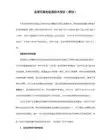
新标准英语四年级上册Module10 Unit1 We have a big family dinner教案一、教学目标1.知识目标:(1)能听说读认单词: family, dinner, New Year, the Spring Festival ,Chinese, peanut, I see.(2)能听懂并会说句子:Happy New Year !At the Spring Festival , we have a big family dinner.We have peanuts and sweets.2.能力目标:使学生能够学会表达新年问候及描述过春节时的风俗习惯。
3.情感目标:培养学生对我国传统节日的认识,培养爱国、爱家的学习氛围,激发学习兴趣,提高将实际生活与英语学习的结合的能力。
二、教学重点:1.New words: family, dinner, New Year, the Spring Festival,Chinese, peanut, I see.2.Sentences : Happy New Year !At the Spring Festival , we have a big family dinner.We have peanuts and sweets.三、教学难点:1、掌握好Spring Festival的发音;2、学生能围绕春节的话题进行谈论。
四、教具、学具准备:配套VCD、多媒体课件、单词卡片、实物。
五、教学过程:Step1、Greeting.T: Hello, boys and girls.(自我介绍)Step2、Warm-up (歌曲导入)T:Do you like music? Do you like singing? . I’ll give you an English song.播放歌曲《新年好》Step3、Presentation.1.T:What is it about? (You can say in Chinese.)当学生说出“春节”,T:Today we will learn about the Spring Festival .教师示范Festival的发音,带领学生练习。
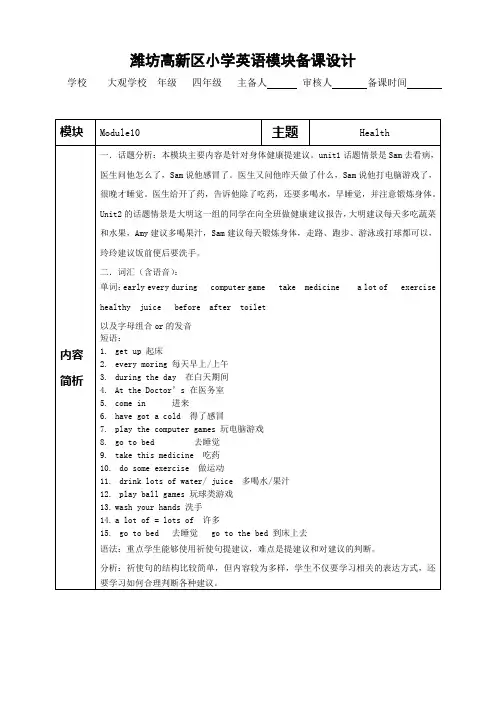
Module 10Unit 1 We have a big family dinner.授课时数:一课时教学目标:Happy New Year!At Spring Festival, we have a big family dinner.功能:表达节日问候以及描述过节时的风俗习惯教学用具:a recorder, word cards, pictures教学程序:1、热身复习老师出示事先准备好的一些食物卡片,询问学生:“What do you like?”引导学生回答:“I like...”老师根据学生的回答把不同的食物卡片分发给学生。
然后询问学生:“What have you got?”引导学生回答:“I’ve got...”或者学生以小组为单位回答:“We’ve got...”2、课文导入老师播放过春节的音乐或者爆竹声,带领学生进入课文的主题。
等音乐完毕,老师问学生:“What is it about?”学生可以用中文说:“春节”。
老师借机教授新单词“Spring Festival”。
然后老师继续提出问题:“What do we say at Spring Festiva l? What do we have at Spring Festival?”请学生以小组为单位进行讨论,然后向全班汇报。
3、课文教学1)老师把本课的挂图贴在黑板上,通过播放录音或教学VCD呈现SB Unit1活动1的内容。
请学生边看图或动画片边听课文录音,尽可能多地理解课文内容。
听过第一遍录音后,老师可以提一些问题,请学生带着问题听第二遍录音,例如:“What’s the book about? What is Spring Festival? At Spring Festival, what do we have?”听过第二遍录音后,请学生试着回答上述问题。
听第三遍录音时,请学生打开书,边听边跟读,同时画出新单词。
老师讲解新单词,帮助学生理解课文。
任务完成2.Do and say –makea survey男”1.Do and say –make a survey学生以小组为单位,在全班范围内开展生活习惯的调查,统计数据,并向全班汇报。
学生之间可以用“Do youeat vegetables everyday?””Do you drink waterevery day?”等语句进行提问。
开展头脑风暴活动,高了学生参与学习的兴趣又为学生自主提意见打下铺垫。
促进语言的综合运用。
2.建议学生养成并坚持好的生活习惯,改掉坏的习惯。
V.Summary& Homework 小结与布置作业1. Summary2.Homework布置作业1.Summary总结本课所学。
2. Homework必做熟读、抄写短文选做:复述并补充健康好习惯。
1.学生自主总结,再次回顾本课所学。
2. 课外延伸,复习巩固本课所学,并能够创造性地运用。
板书设计Yes, the weight scale is broken.Can you guess what he often does?Is he thin at last?2. Read togetherTom is very fat. So, he wants to be…?What does he often do to lose weight?Is he thin at last?healthy. Because he is sofat…Maybe he often eat toomuch…Maybe yes…He wants to be thin.He doesn’t do exercise.He often eats hamburgersand meat.He often drinks cola.He plays mobile game allday.And he gets up at 10o’clock every day.No, he isn’t.的词语,如:big-boned, a littleheavy。
外研版(一起)四年级英语上册教案Module 10 UNIT 1 I've got a stomach ache一、教学内容分析:1. 功能:询问或描述病情及病因。
2. 语言结构:(1)What’s the matter?I’ve got a stomach ache.(2)What did you eat yesterday?I ate chocolate biscuits.二、教学目标:1. 知识目标(1)掌握四会单词和句型结构。
(2)能读懂文章,就文章回答问题并能根据范文仿写。
2. 能力目标(1)在情景中运用生病、就医询问病因等用语。
(2)能准确表达自己的病情及病因。
3. 情感态度目标:(1)进一步提高学生对英语的学习热情,增强学习兴趣。
(2)培养学生积极主动地参与课堂活动,大胆开口,主动模仿。
(3)通过本课的学习使学生更注重保养自己的身体,爱吃的东西也要少吃。
三、基本教学理念(1)开放式教学策略。
创设情景,营造氛围,体现语言教学的真实性。
以有限的课堂为载体,给学生提供足够的空间,充分发挥学生的想象力,培养学生的创新能力。
如:brainstorm, role playing, given situation, acting 等活动。
(2)任务型活动策略。
具体采用情景教学法(Situational Approach),交际教学法(Communicative Approach),整体语言教学法(Whole Language Teaching)等教学方法。
在做中学和练,任务明确,活动面广,使学生在交际中真实运用所学知识。
(3)面向全体学生,关注学生的全面发展。
经常性地开展pair work、group work、class performance,培养学生的团体合作精神。
四、教学设计Step1 Revision热身互动,自然导入。
在教学活动开始我设计了唱他们最爱唱的Children from China are Chinese.活跃课堂气氛,学生在手舞足蹈的过程中不知不觉走入新课。
新标准英语四年级上册Module10 Unit1 We have a big family dinner教案一、教学目标1.知识目标:1)能听说读认单词:family,dinner,New Year,the SpringFestival ,Chinese,,peanut ,I see.2)能听懂并会说句子:Happy New Year ! At Spring Festival , we have a big family dinner.2.能力目标:使学生能够学会表达新年问候及描述过春节时的风俗习惯。
3.情感目标:培养学生对我国传统节日的认识,培养爱国、爱家的学习氛围,激发学习兴趣,提高将实际生活与英语学习的结合的能力。
二、教学重点:1.New words: family,dinner,New Year,the Spring Festival ,Chinese,peanut ,I see.2.Sentences : At Spring F estival,we have ……三、教学难点:1、掌握好Spring Festival的发音;2、学生能围绕春节的话题进行谈论。
四、教具:黑板、多媒体五、教学程序:Step1组织课堂1.Greeting. (Hello, boys and girls. How are you, today?)2.Warm up:Say the chant :I like coffee.Step2学习新课1.歌曲导入师:You are very good . I’ll give you a song.播放歌曲《新年好》,问:What’s it about? You can say in Chines e.2.操练Spring Festiveal1)当学生说出“春节”,师:Yes,it’s.带领学生大量练习。
教师继续引导“Spring Fastiveal is Chinese New Year.”T:Today we will learn about Spring Festival .(练习Spring Festival 的发音)2)Let’s say the chant: Happy New Year!3. Revise some words about the food.If today is spring festival ,I have some presents for you .教师根据大屏幕上的图片,What are they?(生答)问:Do you like apples/pears/oranges/meat/fish……?(生答)教师抽取卡片,用like,have造句子,如I like apples , I have(边说边做吃的动作)apples .I like fish , I have fish.让学生模仿教师根据自己的实际,用I like /d on’t like……,I have …… 来描述事物。
外研版(一起)四年级英语上册
Module 10 UNIT 1 I've got a stomach ache
一、教学内容
第十模块主要让学生学会描述病情,学习动词的过去式,掌握重点句型:What is the matter?
I have got a stomach ache.
What did you eat yesterday?
I ate chocolate biscuits.
Wang fei has got a cold。
二、教学目标
(1)学习和掌握本课的词汇和句型,要求语音规范,语调自然。
(2)能演唱歌谣,要求语音清晰,演唱大方自然。
(3)能运用本节课所学的词汇和句型描述过去没有发生的事和行为。
(4)通过说唱活动培养学生的学习兴趣和英语语感。
三、教学重点
学习和运用句型:
What is the matter?
I have got a stomach ache.
What did you eat yesterday?
I ate chocolate biscuits。
Wang fei has got a cold。
四、教学难点
能够在日常生活中恰当的使用本节课所学的语言知识。
五、教学方法
小组合作学习
六、教具准备
录音带、单词卡片
UNIT 1 I've got a stomachache
一、教学内容
词汇: matter stomach ache medicine chocolate
句型:
What is the matter?
I have got a stomach ache.
What did you eat yesterday?
I ate chocolate biscuits.
Wang fei has got a cold.
二、教学目标
学习和掌握本课的词汇和句型,要求语音规范,语调自然。
(1)能演唱歌谣,要求语音清晰,演唱大方自然。
(2)能运用本节课所学的词汇和句型描述过去的行为。
(3)通过说唱活动培养学生的学习兴趣和英语语感。
三、教学重点
学习和运用句型:
What is the matter?
I have got a stomach ache.
What did you eat yesterday?
I ate chocolate biscuits.
Wang fei has got a cold.
四、教学难点
能够在日常生活中恰当的使用本节课所学的语言知识。
五、教学过程
Step 1: greetings
T: Good afternoon, boys and girls.
S: Good afternoon.
T: Nice to meet you again.
S: Nice to meet you, too.
Step 2: warming-up activity
Sing an English song.
Step 3: Presentation and Practice
(1)老师随意问学生,
What is your favorite food?
My favorite food is cake,
How many cakes can you eat?
I can eat three cakes.
再告诉学生Sam因为吃了过多的饼干觉得很不舒服,所以爸爸带他去医院看病,让我们看看他是怎样向医生描述自己的病情的。
(2)听录音,思考Sam描述的病情,由学生听后回答问题。
(3)再听录音,画出课文中带有生词及短语。
并初步理解句子的意思。
(4)老师再次播放录音,并在每句话后停顿,学生看书,听音,跟读。
老师纠正学生的发音。
(5)分小组合作学习课文内容,基本要求达到组内每一个人都会认读。
学的快的同学尽量达到背诵。
(6)小组学习成果展示。